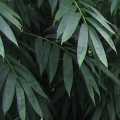|
Bamboo; there are around one and a half thousand species world wide, and new ones still being described. There might be two hundred bamboo species in Australia, and it's hard to know which to grow. We have chosen just a few that grow very well here (now two or three dozen including trials); the best short, cold hardy clumping bamboo plants for landscaping, medium and large plantation species for bamboo shoots and bamboo timber, and black bamboo.
We are not collectors!! There are many bamboos that we would not have for free. None of them appear on this web site. Bamboo is considered a pest or a weed by many people. We ourselves were once among them. And though we now know that some bamboos are undoubtedly amongst the best plants in the world, we are also sure that there are others that should probably be avoided by most people. We grow bamboo that is well suited to the requirements of Australian gardeners, farmers, landscapers and retailers.
Some bamboo species are superb landscaping plants for a wide range of sites in the city, and in both urban and rural areas. Here in Australia, these landscapes are lacking in improvements and features that are better provided by bamboo than by anything else.....
Bamboo screens and hedges, as barriers against wind, dust, noise or prying eyes. Growing privacy screens and windbreaks is a major use for bamboo plants.
Feature plants of great beauty by any standard, and of different shapes and sizes when mature. Some bamboo species are outstanding ornamentals.
Useful ornamentals, producers of food, mulch and craft wood. Soil and slope stabilisers. There's no harm in great looking bamboo plants also being useful ornamental plants.
Hardy plants, extremely fast growing. Self-renewing and predictable. We produce mainly hardy bamboo varieties that are easy to grow.
This table outlines possible selections for bamboo to suit a particular use. We specialise in a small selection of useful, ornamental non-invasive bamboos.
|
Screens
|
Gracilis, Alphonse Karr, Fasca, SSFL, Amoenus, Oldhami, Ventricosa
|
|
Feature Plants
|
Amoenus, Chungi, Ventricosa, Gracilis, Alphonse Karr, Atro, Black Brandisii, Black Asper
|
|
Windbreaks
|
Gracilis, Alphonse Karr, Fasca, Amoenus, Ventricosa, Oldhami
|
|
Timber
|
Atro, Atter, Black Asper, Brandisii, Latiflorus, Black Brandisii, Fasca
|
|
Delicious Shoots
|
Oldhami, Atter, Latiflorus, Brandisii, Black Brandisii, Black Asper
|
|
Books have been written on, and long lists compiled of the many uses of bamboo. Obviously there are many more uses than these basic ones, and many more useful bamboos.

When you select a bamboo species for your particular site there are a few thing you should keep in mind.
First, the size that the mature clump will probably reach. You will find that many bamboo species can vary considerably in size depending on their growing conditions. In shallow soil with minimal feeding and watering, bamboo plants will be smaller and less vigorous, and so the heights mentioned in bamboo descriptions may never be reached. Shoots can easily be shortened while the plants are still small. Also be aware that some bamboos are more upright than others and will take up less space at the same height than others. They can, of course, be pruned back and this can encourage more leaf and branch growth from this point.
Second, consider the type of growing conditions that your plants will have. Cold tolerance is a limiting factor with many of the tropical clumping bamboos , yet many others grow well in the subtropical and temperate zones. Here, we have five or ten light frosts (down to 0 degrees Celsius) most years, with the occasional heavy frost (down to -4 degrees C). At this temperature some species suffer damage; though most of our bamboo is unaffected. Some clumping bamboo species are much more cold hardy than others, and you can find figures of -9 or -12 degrees Celsius recorded as tolerable for some bamboo species; figures we have no way of testing here at Kempsey, Australia.
Bamboo can thrive in very hot weather if it has enough water. In this part of Australia (the Mid North Coast of New South Wales), our rain falls mainly in summer and autumn, a pattern that fits nicely with the requirements of clumping bamboo. Most years we need to irrigate during spring to help extend the growing season. If you have regular water shortages or don't want to water your bamboo much after it's established, then select the most drought hardy species (like Ventricosa, Oldhami, or even Gracilis). If you have little or no soil, you should also choose these tougher bamboos.
Next, if the bamboo is for a particular purpose; to be useful for something, then choose on that basis from plants that meet the first two requirements. Our table of USES may assist here.
Finally consider the ornamental features (colour, texture, form, leaf size, etc.) of the bamboo. If neither size, nor climatic limitations, nor usefulness are important factors at your site , then you can choose purely for appearance.

Screens can be made from living bamboo. They can be trimmed to height and width, and respond well to pruning especially in the growing season. New shoots can be cut just above a node to control height and you can cut all the shoots to the ground where you don't want the clump to expand. It's best to choose a plant that is close to your needs for the minimum maintenance. Some are very cold and wind-hardy and very easy to keep looking good.
When selecting bamboo species to grow in plantations for bamboo shoots and timber production, there are a number of issues to consider. One concern is that gregarious flowering can cause the death of an entire plantation. Another is that a variety that performs well in another area (or another country), may fail to grow well in your location. Then again, there is the question of productivity. Some species will tend naturally to produce more than others (though may require certain inputs or particular conditions to do so), and this will vary further with rainfall, temperature, ground preparation and soil fertility. All this before you consider various management practices. It seems that the best approach may be to conduct your own trials with a number of varieties before committing to any large scale plantings. We have done this with a selection of bamboo species that are major commercial varieties in their countries of origin, and are seeing good results.
Some bamboos are very easy to grow, and maintain. Like some small or medium sized trees, that have become valued landscaping plants. Some have more upright habit than others and will take up less space or require less pruning to keep them compact. Some are simply much easier to grow than others and are in need of less maintenance, and will handle wind or frost that would kill many plants. Others require more attention to keep them looking good, as is the case with many other plants. We have chosen to produce mainly bamboo that once established, will do well with the minimum of attention.
When we first started buying bamboo plants we learnt some important lessons. Price is not necessarily an indication of quality. Bamboo plants can be expensive because they are difficult to propagate (even if they are easy to grow). Or, because they are new imports that have to repay the high costs that this entails. People sell you whatever they have, whatever they like themselves. Some species are difficult to grow and are very unforgiving if they're allowed to dry out just a little they become very shabby and recover very slowly. Others tend to go shabby every winter if not grown in their ideal situation and recover only in spring. Others are invasive and require soil barriers and maintenance to control their spreading habit. Almost nobody mentions mites or mealy bugs, unless you ask about them. You should try to find out about this before you buy. We have learnt these lessons the hard way.
What we have also learnt is that there are a number of truly great bamboos, not only in the traditional or classical sense , but bamboo well suited to modern Australian gardeners and landscapers. Bamboo for the city: homes, parks and gardens. And, bamboo for rural Australia. Non-invasive bamboo plants that can thrive in cold windy sites, as well as the more adaptable tropical species. We have focused on producing commercial quantities of these few plants, rather than a huge and bewildering range for the bamboo collectors' market, which is already well serviced.
No doubt some people will take no notice of any of this and go straight to the Black Bamboo page.
Though we have given our best advice and opinions regarding the various bamboo species we offer for sale, and are glad to provide information about bamboo, and we may even suggest a variety for certain situations, ultimately the choice of plants for your particular site is yours. As mentioned elsewhere you should be aware of the size and nature of anything you plant, not just bamboo.

Top Home Contact Us
Bamboo Cultivation Propagation FAQ
Black Bamboo Pests More Photos Bare Rooted Landscapers
|


